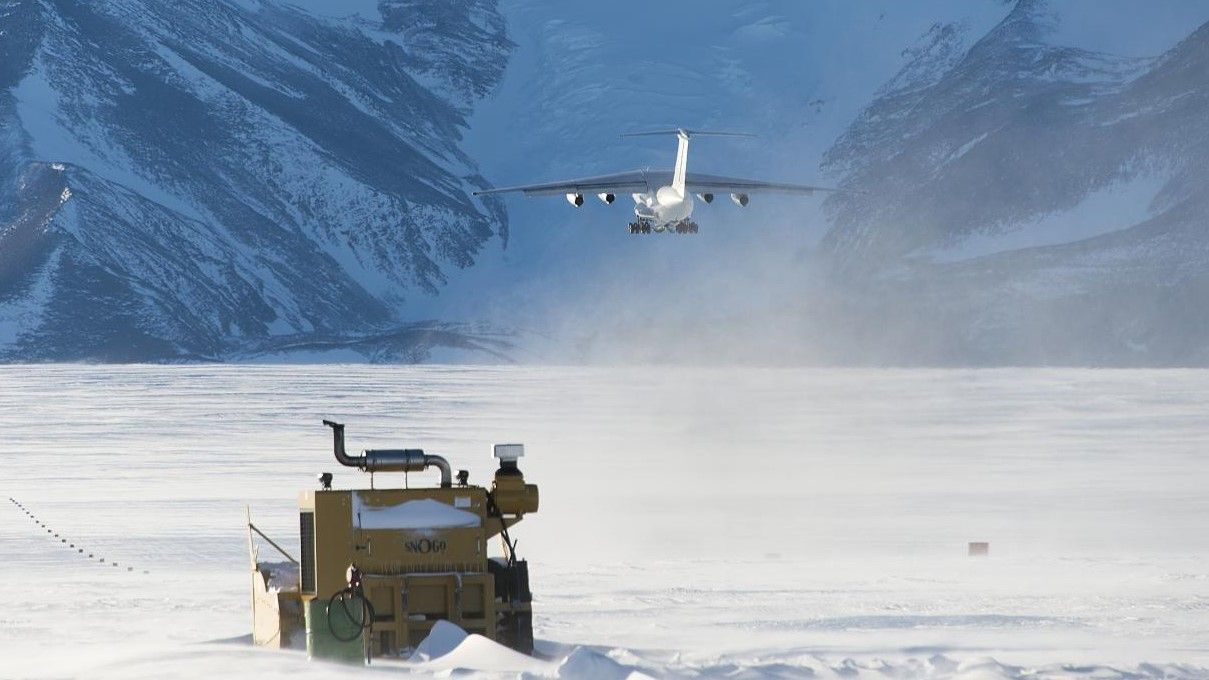Summary
- Constructing and operating ice runways in Antarctica requires meticulous planning and adaptable technology.
- Ice runways are constructed by clearing snow and ice with specialized equipment.
- Advanced Navigation & Positioning Corporation has introduced an innovative Transponder Landing System that provides precision landing guidance for ice runways.
Antarctica is a continent characterized by its extreme conditions and isolated landscapes. It poses unique challenges for supporting any human activity, and aviation is no exception.
In this remote region, where nearly everything necessary for human habitation must be transported from distant locations, creating and maintaining ice runways and the infrastructure that makes them possible is an important job but is no small task. Constructing and operating an ice runway in Antarctica demands meticulous planning and adaptable technology.
Planning and preparation
The development of any structure in Antarctica requires meticulous planning well in advance. In many cases, buildings or projects are planned at least two years ahead to accommodate the unpredictable and challenging conditions of the region.
Establishing a runway begins with selecting an appropriate location – a task assigned to surveyors. The ideal site is chosen based on gradients, which are then marked with flags for reference. This preliminary step sets the foundation for the runway's creation.
Ice runway construction
Specialized equipment is employed to carve out grooves on the ice field. Despite being called "snow groomers," these robust machines are designed to withstand the Antarctic environment and can even feature industrial-grade snow blowers or massive blades for clearing ice. Over a span of about 30 hours, the snow and ice are painstakingly cleared to establish a functional runway. Another 12 hours are typically required to re-clear the runway each time a plane lands.
Antarctica's dynamic environment means that the ice constantly shifts northward toward the ocean at an average rate of about 80 meters per year. As a result, the positioning of the runway needs to be adjusted annually to accommodate this natural movement.
Operational challenges
Once constructed, the runway's challenges persist due to Antarctica's unpredictable weather. Flights to and from the continent are fraught with uncertainty. Pilots navigating these unforgiving skies require optimal conditions, including clear visibility, calm winds, and the absence of snow or rain.
The ice begins to melt during the relatively warmer months of December and January, rendering the runway slippery and unsuitable for landings. This usually means in a whole year, there is a narrow window of opportunity for successful operations when conditions are comparatively favorable.
Innovations in ice runway navigation
Even so, operations in inclement weather are becoming possible, to at least some extent. Advanced Navigation & Positioning Corporation (ANPC) has introduced a groundbreaking solution to overcome the challenges of supporting aircraft operations in Antarctica's ever-shifting environment.
Most normal instrument approaches – which provide lateral and, often, vertical guidance for pilots as they land in low-visibility situations – require a surface that does not move, which is not a realistic possibility in much of Antarctica.
ANPC's Transponder Landing System (TLS) is a software-defined approach to precision landing guidance that offers a full Category I Instrument Landing System (ILS) approach even on ice runways that experience significant annual movement. This innovative system utilizes Multilateration technology to determine an aircraft's position via ground-based transponders. The TLS then provides lateral and vertical guidance to the aircraft, facilitating safe landings despite the dynamic conditions of ice runways.
The flexibility of the TLS is particularly valuable for locations where a traditional ILS installation is impractical, such as airports situated in mountainous terrain, coastal runways, or facilities with spatial constraints. Transportable TLS installations can be rapidly deployed, allowing for quick re-establishment of ILS capability in disaster relief scenarios or seasonal operations such as those in Antarctica.
What else is involved in maintaining and enabling these kinds of aviation operations? Let us know in the comments below.
Sources: CNN, FlightRadar24


